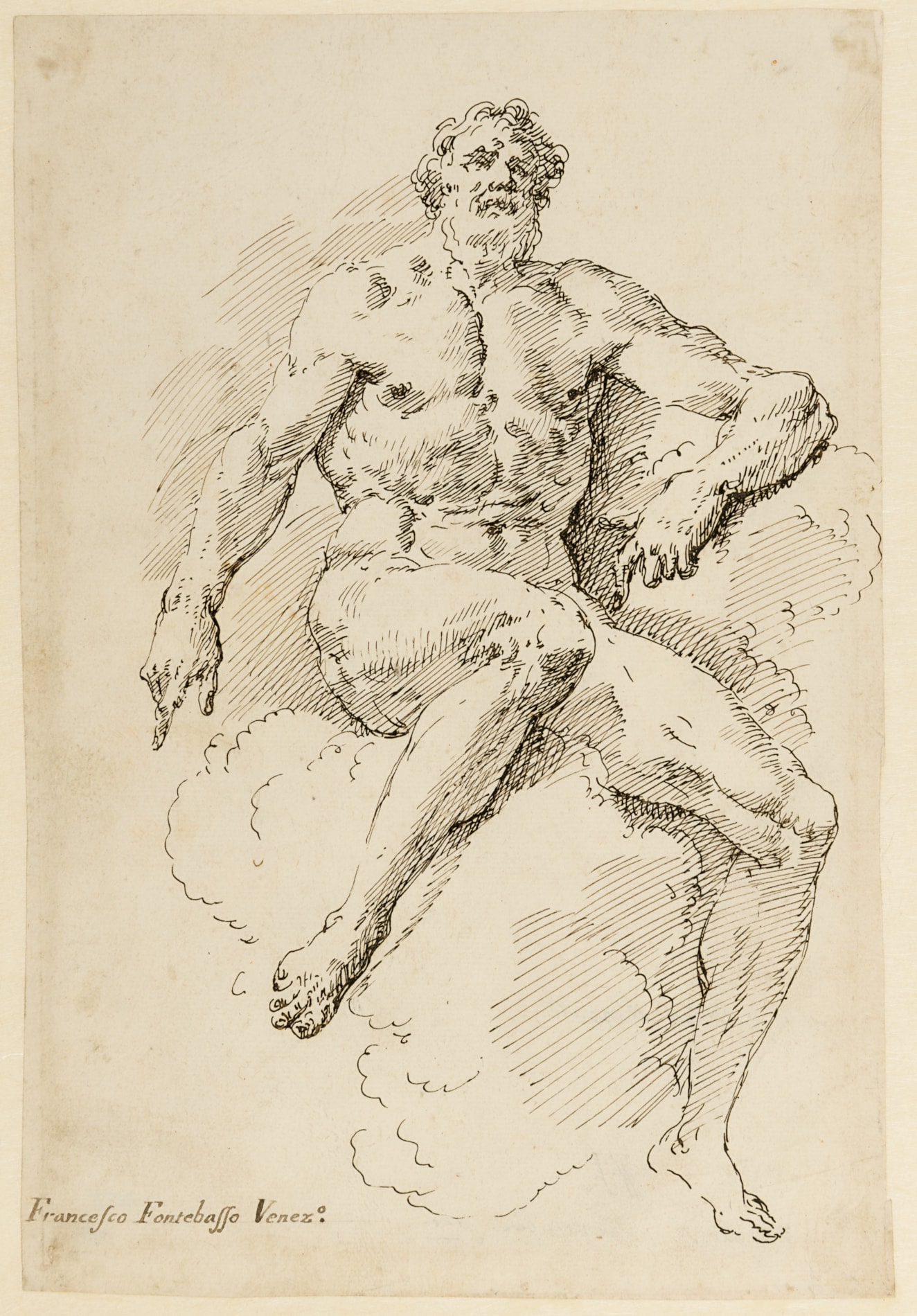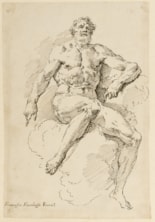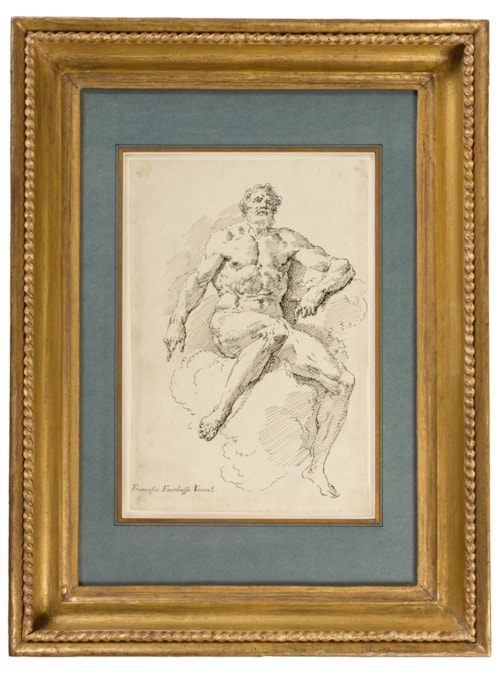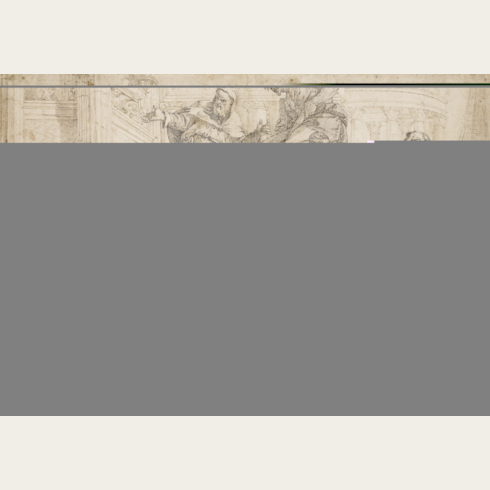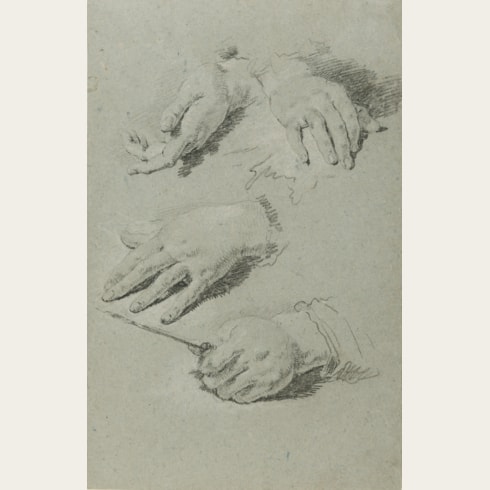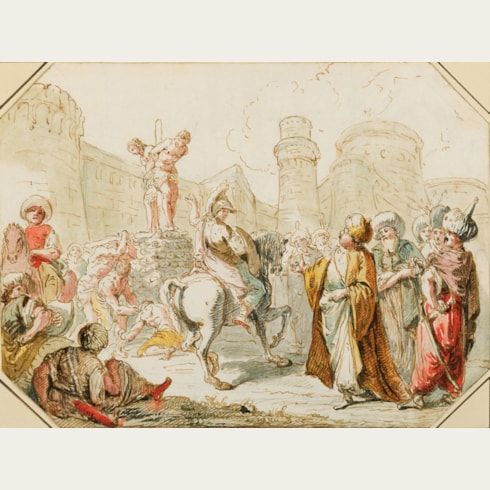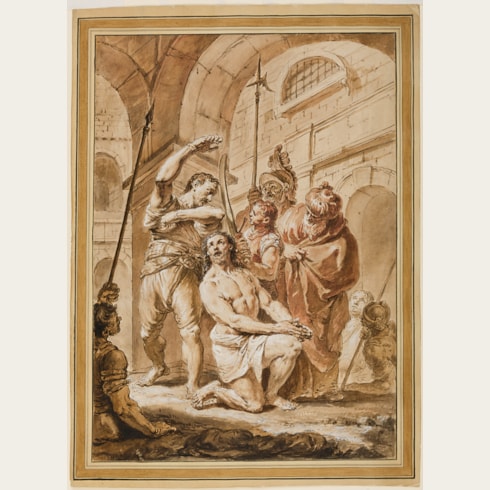Francesco FONTEBASSO
(Venice 1707 - Venice 1769)
Hercules Seated on a Cloud
Pen and black ink.
Inscribed (by the so-called Reliable Venetian Hand) Francesco Fontebasso Venez.o at the lower left.
Further inscribed colln of Dr. Ed. Riggall and [Fon]tebasso F. Hercules. fect. on the verso.
Numbered 458 on the verso.
252 x 172 mm. (9 7/8 x 6 3/4 in.)
Inscribed (by the so-called Reliable Venetian Hand) Francesco Fontebasso Venez.o at the lower left.
Further inscribed colln of Dr. Ed. Riggall and [Fon]tebasso F. Hercules. fect. on the verso.
Numbered 458 on the verso.
252 x 172 mm. (9 7/8 x 6 3/4 in.)
Drawn in a characteristic technique of pen and ink hatching, the present sheet is a fine example of Francesco Fontebasso’s confident draughtsmanship. A closely comparable pen study of a male nude seated on a cloud - part of an album of Fontebasso drawings which was broken up in the 1920s - was with the Venetian art dealer Pietro Scarpa in 1975. Among other stylistically similar pen and ink drawings by the artist is a study of Apollo that, like the present sheet, once belonged to the unknown collector known as the ‘Reliable Venetian Hand’ in the 18th century, and was later in the Byam Shaw and Wallraf collections before being sold at auction in 2001.
The first owner of this Hercules was the aforementioned anonymous 18th century Venetian collector of drawings known today as the ‘Reliable Venetian Hand’. Among the first scholars to discuss this nameless collector were A. E. Popham and James Byam Shaw in the 1930s. As the latter noted of another sheet from the same collection, ‘The inscription in carefully formed letters, balanced on a ruled pencil line, is of a type that occurs on a considerable number of Venetian drawings, especially of the 18th century; the artists thus named are often obscure, but the attributions, so far as I have been able to check them, are invariably correct. All the drawings I have seen with these inscriptions are in English collections, and must surely have belonged to some connoisseur or dealer of the late 18th century, who was either English himself, or supplied the English market. Some day, perhaps, his identity will be discovered.’
Later scholarship has tended to infer that the collector who inscribed his drawings in this distinctive hand was either a Venetian or lived in Venice, and active mainly in the first half of the 18th century. As Jacob Bean has written, ‘Inscriptions in this hand, giving a draughtsman’s name and place of birth, appear in numerous Italian drawings scattered in collections in Europe and America. The collector who so inscribed his drawings was very possibly Venetian, for the larger part of the sheets inscribed are Venetian in origin…This unidentified collector seems to have been an amateur of considerable taste and knowledge; the accuracy of his connoisseurship in Venetian draughtsmanship of the late seventeenth and early eighteenth centuries has won for him the convenient pseudonym of the “Reliable Venetian Hand” or “Reliable Italic Hand”’.
This drawing also bears the initials of the early 19th century English collector William Sharp, who seems to have been mainly active in the 1820s. Sharp assembled a very large collection of prints and drawings that was dispersed at auction over a period of twelve days in March 1878.
The first owner of this Hercules was the aforementioned anonymous 18th century Venetian collector of drawings known today as the ‘Reliable Venetian Hand’. Among the first scholars to discuss this nameless collector were A. E. Popham and James Byam Shaw in the 1930s. As the latter noted of another sheet from the same collection, ‘The inscription in carefully formed letters, balanced on a ruled pencil line, is of a type that occurs on a considerable number of Venetian drawings, especially of the 18th century; the artists thus named are often obscure, but the attributions, so far as I have been able to check them, are invariably correct. All the drawings I have seen with these inscriptions are in English collections, and must surely have belonged to some connoisseur or dealer of the late 18th century, who was either English himself, or supplied the English market. Some day, perhaps, his identity will be discovered.’
Later scholarship has tended to infer that the collector who inscribed his drawings in this distinctive hand was either a Venetian or lived in Venice, and active mainly in the first half of the 18th century. As Jacob Bean has written, ‘Inscriptions in this hand, giving a draughtsman’s name and place of birth, appear in numerous Italian drawings scattered in collections in Europe and America. The collector who so inscribed his drawings was very possibly Venetian, for the larger part of the sheets inscribed are Venetian in origin…This unidentified collector seems to have been an amateur of considerable taste and knowledge; the accuracy of his connoisseurship in Venetian draughtsmanship of the late seventeenth and early eighteenth centuries has won for him the convenient pseudonym of the “Reliable Venetian Hand” or “Reliable Italic Hand”’.
This drawing also bears the initials of the early 19th century English collector William Sharp, who seems to have been mainly active in the 1820s. Sharp assembled a very large collection of prints and drawings that was dispersed at auction over a period of twelve days in March 1878.
A pupil of Sebastiano Ricci, Francesco Fontebasso spent a brief period of study in Rome before returning to his native Venice, where he produced a series of engravings after Ricci’s paintings. He established his career in Venice, painting several altarpieces for local churches, and was soon in some demand as a fresco painter. In 1734 he decorated the ceiling of the church of the Gesuiti in Venice, and two years later painted a fresco cycle for the church of Santa Maria Annunziata in Trent. Fontebasso worked for members of the Venetian aristocracy such as the Barbarigo family, for whom he painted decorative fresco cycles in the Palazzo Duodo and the Palazzo Barbarigo.
Apart from his success as a fresco painter, Fontebasso made a particular specialty of small-scale devotional easel pictures and modelli, and also worked as an engraver and a designer of book illustrations. From 1756 onwards he was a professor at the Accademia Veneziana, and in 1761 he visited St. Petersburg at the invitation of the Empress Catherine II. Fontebasso remained in Russia for almost two years, completing a number of decorative projects for the Winter Palace in St. Petersburg and other Imperial palaces, as well as painting portraits and genre studies. Although appointed a Professor at the Imperial Academy of Arts, he chose to return to Venice in 1762, where he rose to the position of principe of the Accademia in 1768, shortly before his death.
As Filippo Pedrocco has noted, ‘Fontebasso was a prolific draughtsman and produced sparkling, delicate work in the best tradition of the Venetian Rococo.’1 Like his paintings, his drawings are best described as a synthesis of the manner of his teacher Sebastiano Ricci with the drawings of Fontebasso’s slightly older contemporary, Giambattista Tiepolo. As Pedrocco points out, ‘at different stages of his career his graphic work sometimes reflects the influence of one, sometimes the other. He was not simply a passive interpreter of their work, however, and was capable of achieving a high degree of poetry independent of their influence. Examples can be found among his many ‘finished’ drawings, evidently intended for collectors.’ Most of Fontebasso’s drawings are executed in pen and ink, and while only relatively few may be connected with his paintings, several can be related to the handful of etchings that he made.
Provenance
The anonymous 18th century Venetian collector of drawings known as the Reliable Venetian Hand
William Sharp, Manchester (Lugt 2650), with his handwritten initials on the verso
His sale, London, Sotheby’s, 1 March 1878 onwards, part of lot 458 ‘Hercules, by Francesco Fontebasso, pen.)
Dr. Edward J. Riggall, London (according to an inscription on the verso)
Probably his sale, London, Sotheby’s, 6-8 June 1901 [catalogue untraced]
Anonymous sale, London, Christie’s, 11 April 1978, lot 73
Private collection
Anonymous sale (‘he Property of a Collector), London, Christie’s, 6 December 1988, lot 29
rivate collection.
William Sharp, Manchester (Lugt 2650), with his handwritten initials on the verso
His sale, London, Sotheby’s, 1 March 1878 onwards, part of lot 458 ‘Hercules, by Francesco Fontebasso, pen.)
Dr. Edward J. Riggall, London (according to an inscription on the verso)
Probably his sale, London, Sotheby’s, 6-8 June 1901 [catalogue untraced]
Anonymous sale, London, Christie’s, 11 April 1978, lot 73
Private collection
Anonymous sale (‘he Property of a Collector), London, Christie’s, 6 December 1988, lot 29
rivate collection.
Literature
Marina Magrini, ‘Francesco Fontebasso: I disegni’, Saggi e memorie di storia dell’arte, 1990, p.169, p.177, no.47, p.191, under no.165 and p.360, fig.78.

